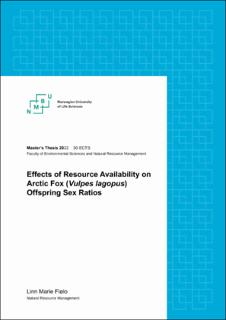| dc.description.abstract | The sex ratio of animals at birth has long been a topic of genetic, evolutionary, and biological interest. In polygynous species, mothers in good condition are typically expected to produce more males, while mothers in poor condition are expected to produce more females.
The Fennoscandian Arctic fox (Vulpes lagopus) population was close to extinction a century ago but has started recovering in the last couple of decades thanks to conservation efforts, including supplemental feeding. This offers an opportunity to study the effects of resource availability, both from supplemental feeding and natural rodent population cycles, on offspring sex ratios in the Arctic fox.
I analysed data from 89 wild fox litters born in the Norwegian Snøhetta population from 2010-2020, and 81 litters born at a captive breeding station from 2006-2021. I compared empirical results on the effect of resource access on offspring sex ratios with predictions from theoretical models on sex ratio determination.
My results show a slight male skew in overall sex ratio. There was no significant effect of the rodent cycle in the wild population, however there was a significant positive correlation between offspring sex ratio (proportion of males) and distance from the den to the nearest active supplemental feeder. I found no significant difference in offspring sex ratios between the breeding station and wild population.
Given that males are the more dispersive sex and females the more philopatric sex, my results are most consistent with the predictions of Julliard’s (2000) model, where mothers should favour the philopatric sex in high-quality habitats and the dispersing sex in poor-quality habitats. The local resource competition hypothesis, which predicts a bias towards the sex most likely to disperse, also supports my results to some extent, but does not account for the spatial variability of resources. Further studies are needed to compare the effects of resources on sex ratios between the wild-born and captive-bred litters. | en_US |

